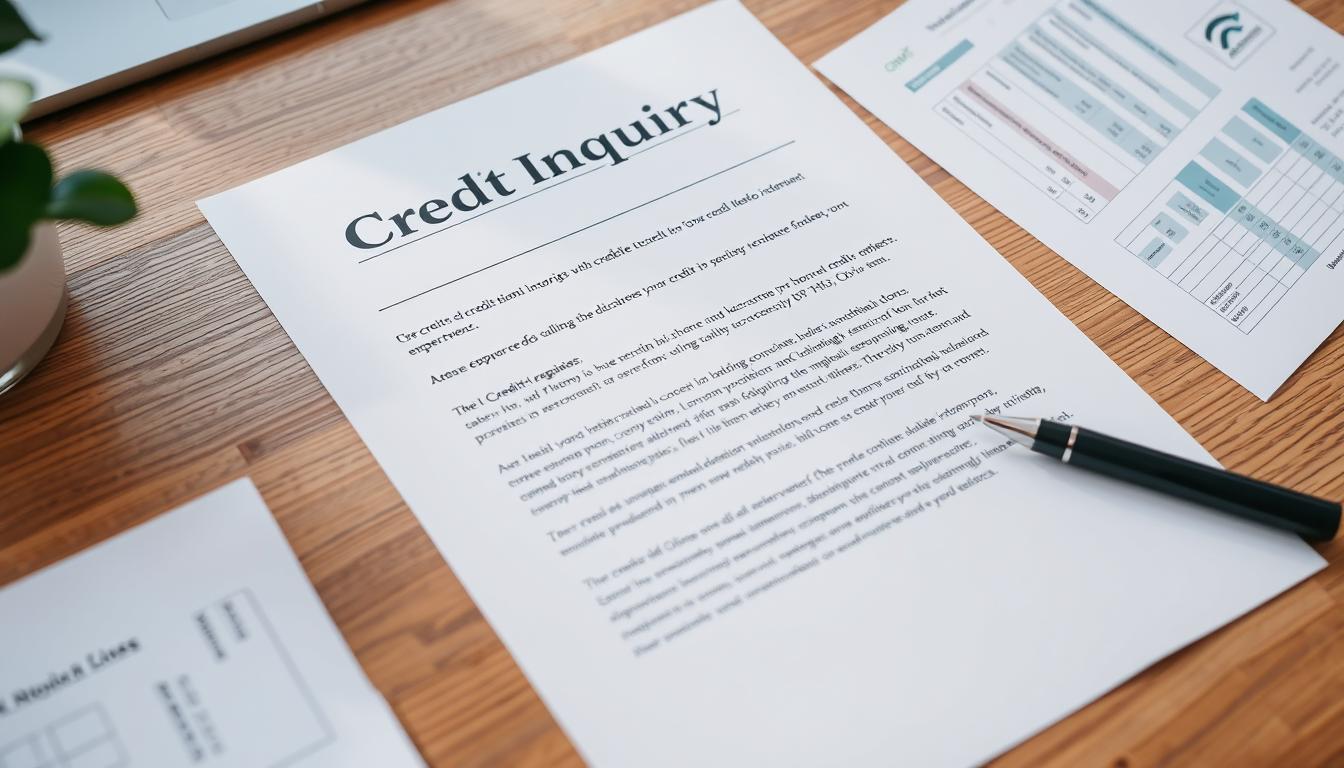A healthy credit profile is vital for financial well-being. Managing unwanted credit inquiries is a key part of this. We offer a free credit inquiry letter PDF template to dispute unauthorized inquiries.
This template helps protect your credit score. You’ll learn how to remove unwanted inquiries and safeguard your credit history. Our guide shows you effective ways to manage your credit profile.
Key Takeaways
- Understand the different types of credit inquiries and their impact on your credit score.
- Learn how to craft an effective credit inquiry letter to dispute unauthorized or inaccurate inquiries.
- Discover the essential elements to include in your credit inquiry letter and the best practices for tone and language.
- Familiarize yourself with the contact information for the major credit bureaus to ensure your letter reaches the right destination.
- Follow up on your credit inquiry letter to ensure the issue is resolved effectively.
Understanding the Impact of Credit Inquiries
Credit inquiries are key in determining your creditworthiness. They can affect your credit score differently. Knowing their impact helps maintain a healthy credit profile.
Credit checks happen when you apply for cards, loans, or refinancing. The type of inquiry matters for your credit score.
Types of Credit Inquiries
There are two main types of credit inquiries: hard inquiries and soft inquiries. Hard inquiries occur when you apply for credit, like a card or loan.
These can negatively impact your credit score. They show you’re seeking new credit. Soft inquiries happen for informational purposes.
Landlords or employers might do soft inquiries. These don’t affect your credit score.
Effects on Credit Scores
Hard inquiries stay on your credit report for up to two years. Each can drop your score by 2 to 5 points.
The impact lessens over time. Multiple inquiries in a short period often count as one. This reduces the overall effect.
Knowing about credit inquiries helps you make smart credit decisions. It can minimize the impact on your score.
| Type of Inquiry | Impact on Credit Score | Duration on Credit Report |
|---|---|---|
| Hard Inquiry | 2-5 points drop | Up to 2 years |
| Soft Inquiry | No impact | Not reported on credit report |

Learning about credit inquiries helps protect your credit. It helps maintain a strong financial profile. Being informed helps you navigate credit issues effectively.
When to Send a Credit Inquiry Letter
A credit inquiry letter helps maintain a healthy credit profile. Send one if you spot unauthorized or inaccurate inquiries on your credit report. Quick action is key to protect your credit standing.
Use a credit inquiry removal request for inquiries you didn’t initiate. These could be from identity theft or lender mistakes. Acting fast helps remove unauthorized inquiries from your report.
A credit report correction letter is useful for misreported or outdated legitimate inquiries. Lenders may fail to update inquiry status. Some inquiries might stay on your report longer than allowed.
- Unauthorized or inaccurate credit inquiries
- Legitimate inquiries that are incorrectly reported or outdated
- Errors or discrepancies in your credit report
A well-crafted credit dispute sample pdf can help fix your credit history. This ensures accuracy in your report. It’s crucial for a strong credit score and better financing options.

Crafting an Effective Credit Inquiry Letter
A well-written credit inquiry letter is crucial for success. This guide will help you create a professional and persuasive letter. We’ll cover key elements and tips for effective communication.
Essential Elements to Include
Your credit inquiry letter should include these important components:
- Your personal information, including your full name, current address, and contact details.
- The specifics of the disputed credit inquiry, such as the creditor’s name, the date the inquiry was made, and a detailed explanation of why you believe the inquiry is unauthorized or inaccurate.
- The desired outcome, whether it’s the removal of the remove hard inquiry letter or a credit dispute resolution for the credit inquiry deletion request.
- Copies of any supporting documentation, such as proof of identity or evidence of the inaccuracy.
Tone and Language Tips
A professional and persuasive tone is vital in your credit inquiry letter. Follow these guidelines for best results:
- Adopt a courteous and respectful tone, addressing the credit bureau representatives by their official titles.
- Stick to clear, concise language and avoid overly emotional or accusatory phrasing.
- Emphasize the facts and reasoning behind your request, rather than relying solely on emotion.
- Remain persistent but polite in your follow-up communications, if necessary.
Use these elements and best practices to write an effective credit inquiry letter. Your letter will be professional and increase your chances of success.

credit inquiry letter pdf
Dealing with unwanted credit inquiries can be tough. Our free credit inquiry letter PDF template can help. It’s a tool to dispute wrong or unauthorized inquiries on your credit report.
The template is easy to customize for your situation. It helps you address mistaken or unauthorized inquiries professionally. You can clearly explain your concerns with this structured format.
Our credit inquiry letter PDF allows you to:
- Clearly explain the reason for your dispute
- Provide relevant supporting documentation
- Request the removal of the disputed inquiry from your credit report
- Follow up on the resolution of your case
This letter is a powerful tool for maintaining good credit. It helps you take charge of your credit history. Get it now to start improving your credit profile.
| Key Benefits | Features |
|---|---|
|
|
Get our free credit inquiry letter pdf template now. Start taking control of your credit profile today.

“Protecting your credit is essential for financial success. Our credit inquiry letter PDF template empowers you to take control of your credit history.”
Addressing the Letter to Credit Bureaus
Disputing credit inquiries requires sending letters to the right place. We’ve gathered contact details for Experian, Equifax, and TransUnion. This information will help you reach out effectively.
Contact Information for Major Credit Bureaus
To send your credit report dispute letter or credit bureau letter template, use these addresses:
- Experian: Experian National Consumer Assistance Center, P.O. Box 4500, Allen, TX 75013
- Equifax: Equifax Information Services LLC, P.O. Box 740256, Atlanta, GA 30374
- TransUnion: TransUnion Consumer Solutions, P.O. Box 2000, Chester, PA 19016
Some credit bureaus accept dispute letters via email. Experian’s email is dispute@experian.com. Equifax and TransUnion have their own dispute email addresses too.
Sending your credit report dispute letter to the right bureau boosts your chances of success. It helps ensure a quick resolution to your credit inquiry dispute.
Requesting Removal of Unauthorized Inquiries
Unauthorized credit inquiries can harm your credit score. They make it harder to get good loan terms or credit card approvals. Luckily, you can request to remove these unwanted inquiries.
Start by finding the unauthorized inquiries on your credit report. Look for inquiries from unfamiliar lenders or those resulting from identity theft. Make a list of these suspicious entries.
Next, gather evidence to support your claim. This may include copies of your credit report and ID documents. Also, collect any relevant correspondence with credit bureaus or lenders.
- Gather supporting documentation: Collect any evidence that can help substantiate your claim of unauthorized inquiries, such as copies of your credit report, identification documents, or written correspondence with the credit bureaus or lenders.
- Draft a credit inquiry removal request letter: Compose a formal letter addressed to the credit bureaus, outlining the specific unauthorized inquiries you wish to have removed and providing the supporting documentation. Be sure to include your personal information, such as your name, address, and date of birth, to ensure the credit bureaus can properly identify your credit file.
- Submit the credit inquiry removal request: Send your letter and supporting documents to the appropriate credit bureaus. The major credit bureaus are Experian, Equifax, and TransUnion, and you’ll need to contact each one individually to address the unauthorized inquiries on your respective credit reports.
- Follow up on your request: Keep track of the status of your credit inquiry removal request and be prepared to follow up with the credit bureaus if you don’t receive a response within the expected timeframe, typically 30 to 45 days.
Credit bureaus must investigate your removal request by law. They typically respond within 30 to 45 days. Be ready to follow up if you don’t hear back.
| Credit Bureau | Contact Information |
|---|---|
| Experian | P.O. Box 4500, Allen, TX 75013 |
| Equifax | P.O. Box 740256, Atlanta, GA 30374 |
| TransUnion | P.O. Box 2000, Chester, PA 19016 |
Taking action to remove unauthorized inquiries protects your credit score. It ensures your credit report accurately shows your financial history. Stay alert and follow through with credit bureaus for best results.
Disputing Legitimate but Inaccurate Inquiries
Credit inquiries may be legitimate but have incorrect details. You can dispute these inquiries and ask for their removal. This helps keep your credit report accurate and can boost your credit score.
Supporting Documentation
When disputing inaccurate credit inquiries, provide strong supporting documents. This strengthens your case and increases your chances of success.
- Copies of any contracts, agreements, or communications with the creditor that initiated the inquiry
- Proof of identity, such as a driver’s license or passport, to confirm your identity and the legitimacy of the dispute
- A detailed credit dispute sample pdf outlining the specific inaccuracies and your request for removal
Gather and submit these documents to prove the inquiry’s inaccuracy. This increases the likelihood of its removal from your credit report.
| Credit Bureau | Contact Information |
|---|---|
| Experian | P.O. Box 4500, Allen, TX 75013 |
| Equifax | P.O. Box 740256, Atlanta, GA 30374 |
| TransUnion | P.O. Box 2000, Chester, PA 19016 |
Fixing inaccurate credit inquiries protects your financial health. Follow the right steps and provide proper documentation. This can help remove wrong inquiries and improve your credit profile.
Following Up on Your Credit Inquiry Letter
Persistence is key when dealing with credit disputes. After sending your remove hard inquiry letter, follow up to ensure a timely resolution. Diligent follow-up increases your chances of a favorable outcome.
To effectively follow up on your credit dispute resolution, consider these steps:
- Track Your Submission: Record when you sent your credit inquiry letter. Keep any confirmation numbers or receipt details. This helps you monitor your dispute’s progress.
- Be Patient, but Persistent: Credit bureaus must investigate disputes within 30 days. If you don’t get a response, follow up politely.
- Escalate the Issue: If the bureau fails to address your dispute, consider filing a complaint. You can contact the Consumer Financial Protection Bureau (CFPB) or your state’s consumer agency.
- Seek Additional Assistance: If challenges persist, consider help from a credit repair specialist. Consumer advocacy organizations can also provide guidance and speed up resolution.
Consistency and proactivity are crucial when handling credit disputes. By following up regularly, you can protect your credit report’s accuracy. Stay organized throughout the process for the best results.
“The key to successfully resolving credit disputes is to stay organized, persistent, and informed throughout the process.”
Conclusion
A credit inquiry letter helps maintain a healthy credit profile and protects your credit score. It’s a tool to remove unauthorized or inaccurate inquiries from your credit report. Follow the steps we’ve outlined for effective results.
Being proactive and well-informed is crucial when dealing with credit inquiry issues. Craft a compelling letter and follow up persistently. This approach helps you take control of your credit history.
A clean credit report is vital for your financial health. It helps secure better interest rates and loan access. Use credit inquiry letters to safeguard your credit score and financial well-being.

